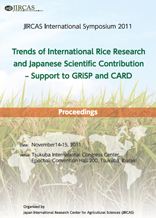Recent Developments in Yield Increasing Theory Focusing on Nitrogen Use Efficiency

Increasing the yield potential of rice in response to global population increases and arable land decreases
is a crucial research target. The approaches to meeting this goal are new varieties development together with
innovative crop managements. Particularly, water scarcity is a challenge for the future in rice-growing regions,
and alternate wetting and drying (AWD) rice cultivation and aerobic rice cultivation have been developed to
address this issue (Bouman et al. 2007). To innovate the rice production system adapted to low fertilizer input
is another approach for the future of our resource limited globe. For this purpose, we have been trying to
clarify the genetic factor(s) of root N uptake characteristics and root system development. Obara et al. (2011)
mapped and verified the quantitative trait locus/loci (QTL) for root elongation in response to exogenous NH4
+
concentration and estimated the candidate gene responsible for that QTL by comparative mapping with genes
for NH4
+ uptake and nitrogen metabolism. Rice breeding program with DNA marker by using genes related to
beneficial root trait as well as other traits such as plant architecture and yield components will be carried out
by close collaboration with crop physiologist and agronomists in the JIRCAS project entitled “Rice innovation
for environmentally sustainable production systems (2011-2015)”.
Kirk et al. (2001) simulated the uptake of nitrogen near root surface and estimated the significant uptake
of NO3
- (one third of N uptake) by rice root even under the submerged condition, although rice plant was
belived to take up nitrogen mainly as NH4
+ under submerged soil condition. The production of NO3
- is
attributed to the nitrification of NH4
+ near root surface where oxygen is transported from atmosphere through
aerenchyma. The synergistic effect of NH4
+ and NO3
- on N uptake was shown where NO3
- seems more
favorable than NH4
+ in terms of its uptake and storage/assimilation (Kronzucker et al.1999). Duan et al.
(2006) supported this estimate by using hydroponically grown rice plants. According to their results, there is
also a varietal differences in the effect of NO3
- on biomass production and grain yield when both nitrogen
sources are applied. Analysis by Michaelis-Menten kinetics showed that NO3
- affect Vmax rather than Km of
NH4
+ uptake (Duan et al. 2007). This suggests the beneficial effect of NO3
- on NH4
+ transporters. The
molecular biological study on the mechanism of this NO3
- effect was also carried out (Zhao et al. 2008 ).
We examined the response of several rice varieties under NH4
+, NO3
-, and partial nitrate nutrition (NH4
+/
NO3
-) in solution culture (Senoo et al. 2007). Result showed that rice varieties can be grouped by their
biomass production; improved varieties have relatively low physiological N use efficiency (PNUE) while
some native varieties have higher PNUE, especially under partial nitrogen nutrition.The increase in biomass
production was attributable both to the higher N uptake and higher PNUE with NO3
- nutrition.
Submerged paddy field condition has been believed to show the higher yield potential of lowland rice
than upland conditions. However, recent investigations by Kato et al. (2009) and Katsura et al. (2010) have
suggested the possibility that upland condition without severe water stress could be more appropriate to show
the potential ability of rice plant. Katsura et al. (2010) showed the significantly higher radiation use efficiency
(RUE) as well as higher fraction of radiation intercepted under upland conditions compared to submerged
ones. Thakur et al. (2010) assessed the physiological effects of saturated water management practice
comparing with submerged soil conditions and showed higher intercepted radiation during the reproductive
stage as well as increase of rooting depth and RUE for saturated water management. These findings suggest
the involvement of nitrate uptake for such improved RUE. The genetic and physiological study of partial nitrogen nutrition in rice plant could contribute to the
increase of nitrogen use efficency of rice plant, hence yield increase under lower nitrogen application
environment would be feasible if the aerobic or at least non-severe reductive soil condition without water
stress could be achieved by proper water saving management of paddy field.
| Date of issued | |
|---|---|
| Creator | Kazunobu Toriyama Sachiko Senoo-Namai Mitsuhiro Obara Yoshimichi Fukuta |
| Subject |
Nitrogen Root system Aerobic soil AWD Yield potential Radiation use effciency |
| Publisher | Japan International Research Center for Agricultural Sciences |
| Available Online | |
| Issue | 2011 |
| spage | 158 |
| epage | 164 |
| Rights | Japan International Research Center for Agricultural Sciences |
| Language | eng |
